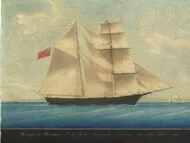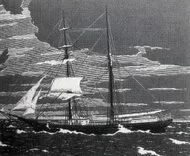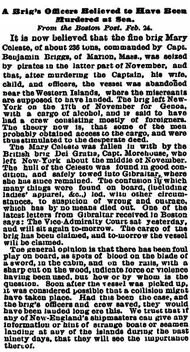 Originally built in Nova Scotia and named the Amazon in 1861, this ghost ship was re-named the Mary Celeste in 1869 after numerous misfortunes and owners. One might say the Mary Celeste was cursed from the beginning. On its last voyage, the Mary Celeste left New York City in November of 1872, carrying methanol and ten people as it headed for Genoa, Italy. Two of the ten aboard were passengers.
Originally built in Nova Scotia and named the Amazon in 1861, this ghost ship was re-named the Mary Celeste in 1869 after numerous misfortunes and owners. One might say the Mary Celeste was cursed from the beginning. On its last voyage, the Mary Celeste left New York City in November of 1872, carrying methanol and ten people as it headed for Genoa, Italy. Two of the ten aboard were passengers.
 In December of 1872, the Mary Celeste was found drifting off of the coast of Portugal - solid and with cargo. None of the crew or passengers were ever found. The ship appeared deliberately abandoned, as its life boat had been launched. Mysterious blood stains were found on three railings, and a blood stained sword was also found hidden under the Captain's bed.
In December of 1872, the Mary Celeste was found drifting off of the coast of Portugal - solid and with cargo. None of the crew or passengers were ever found. The ship appeared deliberately abandoned, as its life boat had been launched. Mysterious blood stains were found on three railings, and a blood stained sword was also found hidden under the Captain's bed.
There has been much speculation as to what happened aboard the Mary Celeste, but no one knows for sure. The following excerpt and image is from a newspaper clipping that ran in the New York Times - an article (February 26, 1873) about the disappearance of the doomed ship:
A Brig's Officers Believed to Have Been Murdered at Sea
From the Boston Post. Feb. 24.
It is now believed that the fine brig Mary Celeste, of about 236 tons, commanded by Capt. Benjamin Briggs, of Marion, Mass., was seized by pirates in the latter part of November, and that after murdering the Captain, his wife, child, and the officers, the vessel was abandoned near the Western Islands, where the miscreants are supposed to have landed. The brig left New York on the 17th of November for Genoa, with a cargo of alcohol, and is said to have had a crew consisting mostly of foreigners. The theory now is, that some of the men probably obtained access to the cargo, and were thus stimulated to the desperate deed.
The Mary Celeste was fallen in with by the British brig Dei Gratia, Capt. Morehouse, who left New York about the middle of November. The hull of the Celeste was found in good condition, and safely towed into Gibraltar, where she has since remained. The confusion in which many things were found on board, (including ladies' apparel, &c.,) led, with other circumstances, to suspicion of wrong and outrage, which has by no means died out. One of the latest letters from Gibraltar received in Boston says: The Vice-Admiralty Court sat yesterday, and will sit again to-morrow.The cargo of the brig has been claimed, and to-morrow the vessel will be claimed.
The general opinion is that there has been foul play on board, as spots of blood on the blade of a sword, in the cabin, and on the rails, with a sharp cut on the wood, indicate force or violence having been used, but how or by whom is the question. Soon after the vessel was picked up, it was considered possible that a collision might have taken place. Had this been the case, and the brig's officers and crew saved, they would have been lauded long ere this. We trust that if any of New England's shipmasters can give any information or hint of strange boats or seamen landing at any of the islands during the past ninety days, that they will see the importance thereof.


